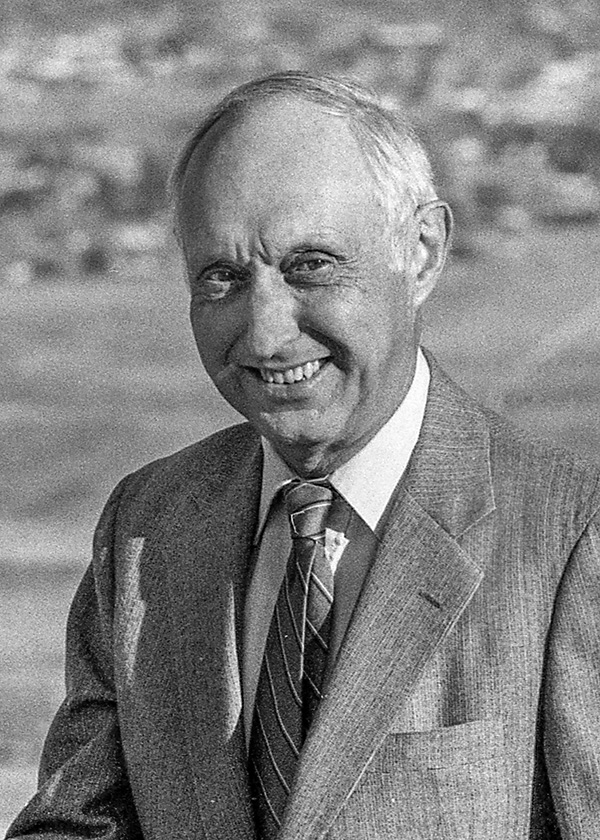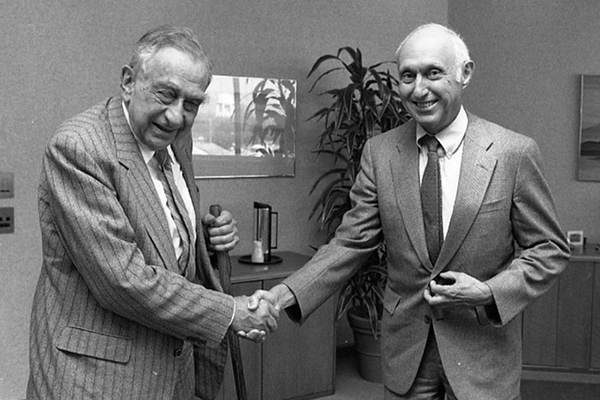A quick wit, a fine mind, and a common touch marked his tenure at Labs

When Sandians who have been around a while think about Irwin Welber, who served as Sandia president and Laboratories director from 1986-1989, they remember an engaged and engaging leader who made a special effort to connect with members of the workforce across the entire Labs. They also remember him as a steady hand in a time of federal budget uncertainties and layoff rumors.
Irwin, who came to Sandia from Bell Laboratories in 1985 as executive VP to then-President George Dacey, passed away on Dec. 17 at age 92.
In an interview with the Lab News upon assuming Sandia’s top job, Irwin said, “In taking on this responsibility I am most fortunate in being able to work with George [Dacey] during my first few months on this job. Sandia has earned and holds the respect of many key government people. I saw this first-hand during my recent visit to Washington, when I was introduced to them. The people of Sandia National Laboratories, because of their contribution to the nation’s security, are viewed as a national resource. And George has been instrumental in projecting these contributions. In one of our meetings with someone who had not met George before, he was greeted with, ‘It is an honor to meet a legend in his own time!’” Irwin told the Lab News that the job offer to lead Sandia was a life-changer.

“A year or two ago,” he recounted, “I said to my wife that the only thing that could really change my future plans would be to be offered a job at Sandia. I didn’t even say president, just ‘a job at Sandia,’ I said, ‘but that’s impossible.’ But, I said, that might change my plans. And, lo and behold, it came to pass. Again, I did not lobby for the job, I did not seek it, but having been offered it, I will serve. And with pleasure.”
‘A real delight’
Irwin was respected for actively trying to understand the Sandia workforce and the work done here. He was noted for lunching in the cafeteria with staff members, who found him receptive and likable, an impression reinforced by the observations of Rosalie Crawford, secretary to nine Sandia presidents, including Irwin. She described him as having “a wonderful, dry sense of humor; it sometimes hit you when you least expected it. Quick mind, fast on his feet, a real delight.”
In a tribute to Irwin on the Albuquerque-based French Funerals website, former Sandia VP Roger Hagengruber wrote, “I worked for Irwin at Sandia as one of his vice presidents. I found him to be a great boss and a truly delightful person. He had a warm personality and a tremendous sense of humor. . . . I found him to be a very capable and mentoring person who was a pleasure to work for and with at Sandia. I will miss him and value the time we had together. May God be with him.”
Irwin began his career at Bell Labs in 1950. An electrical engineer, his work focused on transmission systems. He was responsible for ground communication equipment and technical coordination with foreign partners during the Telstar satellite program of the early 1960s and went on to oversee AT&T’s transmission systems.
Upon becoming president of the Labs, Irwin understood that people, some of the most gifted and technically accomplished people in the world, would have questions. As he put it to the Lab News, “It is natural to ask, ‘What prepared me for this position?’ If I fully understood the job, I could answer the question. But what I can tell you are some of the things I have done that seem to relate to Sandia’s activities. During the early 1960s I dealt with NASA on satellite communications projects. Since that agency and AT&T were both launching their own version of a satellite in the same time frame, there were delicate negotiations required to meet a tight schedule for our Telstar satellite.
“For the past nine years I have worked with the National Security Agency [NSA] on enhancing the security of our Common Carrier microwave systems. Most recently, we have bid and been awarded a development contract by NSA for an advanced version of a secure telephone. . . . The major part of my time at Bell Labs, however, has been occupied with the design of the transmission network for the Bell System and now AT&T.”
Irwin’s tenure at Sandia facilitated the push for transferring technology from government laboratories to the private sector, particularly in support of industries considered vital to national defense. This included a deliberate increase in interactions regarding compound semiconductor R&D and manufacturing.
In the late 1980s, congressional concern about maintaining a competitive edge in semiconductor manufacturing led to additional funding for new facilities. These and expanded collaboration with universities increased Sandia’s research profile, while procedures were established to increase partnerships with industry, including the SEMATECH consortium of semiconductor manufacturers.

Supported important new initiatives
Irwin also actively supported both existing lines of work and new initiatives. Sandia’s energy research received a boost in advanced coal technologies and geosciences, as well as in the nuclear power plant arena, which resulted in the creation of the new Exploratory Nuclear Power Development directorate (6500). Sandia hosted the Stocktake meeting between the US and UK for the first time in 1987.
The Labs became involved in research in support of the Strategic Defense Initiative. And, in 1986, at Irwin’s request, the Office Automation Subcommittee embarked on a quest for a single word processing application to be the standard across Sandia.
Reflecting the increase in systems work and the regular realignment of different areas of work, Irwin also instituted a major reorganization within the Laboratories in late 1986, creating an Exploratory Systems Division headed by Roger Hagengruber and a new Computer Sciences and Mathematics directorate. A variety of other organization mergers and moves took place as well.
Irwin presented a calm face to the Labs during more disruptive moments, including budget concerns raised as a result of the Gramm-Rudman-Hollings Deficit Reduction Act that placed constraints on the federal budget.
Stating clearly that Sandia’s purpose was to serve national needs, not preserve itself, he nevertheless quelled rumors of layoffs and oversaw the complexities of maintaining a relatively level workforce in the face of budget uncertainties. He consistently expressed a belief in the importance and effectiveness of Sandia’s workforce, insisting that, “The key is a good tech base and the kind of people who understand what the problems are, creative people.”
Born on March 3, 1924, in Amsterdam, New York, Irwin is survived by his sons, Peter, Paul, and David; brothers Herb and Jack; sister, Shirley Stone; and grandchildren Jeff and Kelsey Welber. His beloved wife, Ellen, passed away in February of 2015.